Assessing the Benefits of Climate-Sensitive Design with Nature-Based Solutions for Climate Change Adaptation in Urban Regeneration: A Case Study in Cheltenham, UK
Abstract
:1. Introduction
2. Materials and Methods
2.1. Study Area
2.2. Research through Design (RtD) and Design Scenarios
- -
- Establishment of 600 parking spaces.
- -
- Implementation of a brown and green shading system.
- -
- Integration of solar panels to power electric vehicle recharge stations.
- -
- Inclusion of rain gardens and wetlands.
- -
- Incorporation of buffering zones.
- -
- Application of permeable paving.
- -
- Provision of bicycle racks.
- -
- A minimum of 400 parking spaces.
- -
- Incorporation of electric vehicle recharge stations.
- -
- Creation of a pond and wetlands.
- -
- Establishment of buffering zones.
- -
- Installation of bicycle racks.
- -
- Implementation of permeable paving.
2.3. Modelling
2.4. Environmental and Weather Data
2.5. CCWeatherGen Tool
2.6. NBS Species Selection
- Field maple tree, young, middle, and old age
- Oak tree, old and middle age
- Hazel, young and old age
- Birch, young and medium age
- Hawthorn, young age
- 25 cm and 40 cm grass and vegetation
2.7. Data Analysis and Mapping
3. Results
3.1. Existing 2017 and 2050 Mapped Results
3.2. The 30% Nature-Based Solution Implementation Mapped Results in 2017 and 2050
3.3. The 50% Nature-Based Solution Implementation Mapped Results in 2017 and 2050
3.4. A Comparative Analysis of NBS Scenarios and Thermal Comfort
3.5. Potential Air Temperature Changes in Existing and 30% NBS Scenarios
3.6. Potential Air Temperature Changes in Existing and 50% NBS Scenarios
3.7. Mean Radiant Temperature Changes in Existing and 30% NBS Scenarios
3.8. Mean Radiant Temperature Changes in Existing and 50% NBS Scenarios
3.9. Mean Radiant Temperature Changes in 30% and 50% NBS Scenarios
4. Discussions
4.1. The Potential Microclimatic Benefits of Converting Car Park Spaces into Nature-Based Solutions for Climate-Resilient Spaces
4.2. Opportunities and Challenges in the Reduction of Car Park Spaces for Climate Change Adaptation
4.3. Research Limitations and Strengths
5. Conclusions
Supplementary Materials
Author Contributions
Funding
Institutional Review Board Statement
Data Availability Statement
Acknowledgments
Conflicts of Interest
References
- Abbass, K.; Qasim, M.Z.; Song, H.; Murshed, M.; Mahmood, H.; Younis, I. A review of the global climate change impacts, adaptation, and sustainable mitigation measures. Environ. Sci. Pollut. Res. 2022, 29, 42539–42559. [Google Scholar] [CrossRef]
- Shi, W.; Wang, S.; Yang, Q. Climate change and global warming. Rev. Environ. Sci. Bio/Technol. 2010, 9, 99–102. [Google Scholar] [CrossRef]
- Norton, B.A.; Coutts, A.M.; Livesley, S.J.; Harris, R.J.; Hunter, A.M.; Williams, N.S.G. Planning for cooler cities: A framework to prioritise green infrastructure to mitigate high temperatures in urban landscapes. Landsc. Urban Plan. 2015, 134, 127–138. [Google Scholar] [CrossRef]
- Croeser, T.; Garrard, G.E.; Visintin, C.; Kirk, H.; Ossola, A.; Furlong, C.; Clements, R.; Butt, A.; Taylor, E.; Bekessy, S.A. Finding space for nature in cities: The considerable potential of redundant car parking. npj Urban Sustain. 2022, 2, 27. [Google Scholar] [CrossRef]
- Oke, T.R. The energetic basis of the urban heat island. Q. J. R. Meteorol. Soc. 1982, 108, 1–24. [Google Scholar] [CrossRef]
- Koppe, C.; Kovats, S.; Jendritzky, G.; Menne, B. Heat-Waves: Risks and Responses; Health and Global Environmental Change Series, No. 2; World Health Organization, Regional Office for Europe: København, Denmark, 2004. [Google Scholar]
- Katila, P.; Colfer, C.J.P.; de Jong, W.; Galloway, G.; Pacheco, P.; Winkel, G. (Eds.) Sustainable Development Goals: Their Impacts on Forests and People; Life Sciences; Cambridge University Press: Cambridge, UK, 2019; ISBN 9781108765015. [Google Scholar]
- Taylor, K. Europe Has World’s Highest Death Rate from Heatwaves: Study. Available online: https://www.euractiv.com/section/climate-environment/news/europe-has-highest-share-of-global-deaths-from-heatwaves-and-air-pollution-study/ (accessed on 20 September 2023).
- Public Health England. PHE Heatwave Mortality Monitoring—Summer 2017; Public Health England: London, UK, 2019. [Google Scholar]
- Basu, R. High ambient temperature and mortality: A review of epidemiologic studies from 2001 to 2008. Environ. Health 2009, 8, 40. [Google Scholar] [CrossRef] [PubMed]
- Russo, A.; Cirella, G.T. Urban Sustainability: Integrating Ecology in City Design and Planning. In Sustainable Human–Nature Relations: Environmental Scholarship, Economic Evaluation, Urban Strategies; Cirella, G.T., Ed.; Springer: Singapore, 2020; pp. 187–204. ISBN 978-981-15-3049-4. [Google Scholar]
- Marvuglia, A.; Koppelaar, R.; Rugani, B. The effect of green roofs on the reduction of mortality due to heatwaves: Results from the application of a spatial microsimulation model to four European cities. Ecol. Modell. 2020, 438, 109351. [Google Scholar] [CrossRef]
- Iungman, T.; Cirach, M.; Marando, F.; Pereira Barboza, E.; Khomenko, S.; Masselot, P.; Quijal-Zamorano, M.; Mueller, N.; Gasparrini, A.; Urquiza, J.; et al. Cooling cities through urban green infrastructure: A health impact assessment of European cities. Lancet 2023, 401, 577–589. [Google Scholar] [CrossRef]
- Palazzo, E.; Rani, W.N.M.W.M. Regenerating Urban Areas Through Climate Sensitive Urban Design. Adv. Sci. Lett. 2017, 23, 6394–6398. [Google Scholar] [CrossRef]
- Mokhtari, Z.; Barghjelveh, S.; Sayahnia, R.; Karami, P.; Qureshi, S.; Russo, A. Spatial pattern of the green heat sink using patch- and network-based analysis: Implication for urban temperature alleviation. Sustain. Cities Soc. 2022, 83, 103964. [Google Scholar] [CrossRef]
- Sessa, M.R.; Russo, A.; Sica, F. Opinion paper on green deal for the urban regeneration of industrial brownfield land in Europe. Land Use Policy 2022, 119, 106198. [Google Scholar] [CrossRef]
- McCarthy, L.J.; Russo, A. Exploring the role of nature-based typologies and stewardship schemes in enhancing urban green spaces: Citizen perceptions of landscape design scenarios and ecosystem services. J. Environ. Manag. 2023, 346, 118944. [Google Scholar] [CrossRef]
- Kumar, P.; Debele, S.E.; Sahani, J.; Rawat, N.; Marti-Cardona, B.; Alfieri, S.M.; Basu, B.; Basu, A.S.; Bowyer, P.; Charizopoulos, N.; et al. Nature-based solutions efficiency evaluation against natural hazards: Modelling methods, advantages and limitations. Sci. Total Environ. 2021, 784, 147058. [Google Scholar] [CrossRef]
- Gómez, G.; Frutos, B.; Alonso, C.; Martín-Consuegra, F.; Oteiza, I.; De Frutos, F.; Castellote, M.M.; Muñoz, J.; Torre, S.; Fermoso, J.; et al. Selection of nature-based solutions to improve comfort in schools during heat waves. Int. J. Energy Prod. Manag. 2021, 6, 157–169. [Google Scholar] [CrossRef]
- Goodwin, S.; Olazabal, M.; Castro, A.J.; Pascual, U. Global mapping of urban nature-based solutions for climate change adaptation. Nat. Sustain. 2023, 6, 458–469. [Google Scholar] [CrossRef]
- Kiddle, G.L.; Bakineti, T.; Latai-Niusulu, A.; Missack, W.; Pedersen Zari, M.; Kiddle, R.; Chanse, V.; Blaschke, P.; Loubser, D. Nature-Based Solutions for Urban Climate Change Adaptation and Wellbeing: Evidence and Opportunities From Kiribati, Samoa, and Vanuatu. Front. Environ. Sci. 2021, 9, 442. [Google Scholar] [CrossRef]
- Zardo, L.; Geneletti, D.; Pérez-Soba, M.; Van Eupen, M. Estimating the cooling capacity of green infrastructures to support urban planning. Ecosyst. Serv. 2017, 26, 225–235. [Google Scholar] [CrossRef]
- Grace, M.; Balzan, M.; Collier, M.; Geneletti, D.; Tomaskinova, J.; Abela, R.; Borg, D.; Buhagiar, G.; Camilleri, L.; Cardona, M.; et al. Priority knowledge needs for implementing nature-based solutions in the Mediterranean islands. Environ. Sci. Policy 2021, 116, 56–68. [Google Scholar] [CrossRef]
- Furchtlehner, J.; Lehner, D.; Lička, L. Sustainable Streetscapes: Design Approaches and Examples of Viennese Practice. Sustainability 2022, 14, 961. [Google Scholar] [CrossRef]
- Fahmy, M.; Ibrahim, Y.; Hanafi, E.; Barakat, M. Would LEED-UHI greenery and high albedo strategies mitigate climate change at neighborhood scale in Cairo, Egypt? Build. Simul. 2018, 11, 1273–1288. [Google Scholar] [CrossRef]
- Cortes, A.; Rejuso, A.J.; Santos, J.A.; Blanco, A. Evaluating mitigation strategies for urban heat island in Mandaue City using ENVI-met. J. Urban Manag. 2022, 11, 97–106. [Google Scholar] [CrossRef]
- Kridakorn Na Ayutthaya, T.; Suropan, P.; Sundaranaga, C.; Phichetkunbodee, N.; Anambutr, R.; Suppakittpaisarn, P.; Rinchumphu, D. The influence of bioretention assets on outdoor thermal comfort in the urban area. Energy Rep. 2023, 9, 287–294. [Google Scholar] [CrossRef]
- Ge, M.; Huang, Y.; Zhu, Y.; Kim, M.; Cui, X. Examining the Microclimate Pattern and Related Spatial Perception of the Urban Stormwater Management Landscape: The Case of Rain Gardens. Atmosphere 2023, 14, 1138. [Google Scholar] [CrossRef]
- Oke, T.; Mills, G.; Christen, A.; Voogt, J. Climate-Sensitive Design. In Urban Climates; Cambridge University Press: Cambridge, UK, 2017; pp. 408–452. [Google Scholar]
- Lin, P.; Song, D.; Qin, H. Impact of parking and greening design strategies on summertime outdoor thermal condition in old mid-rise residential estates. Urban For. Urban Green. 2021, 63, 127200. [Google Scholar] [CrossRef]
- Nieuwenhuijsen, M.J.; Khreis, H. Car free cities: Pathway to healthy urban living. Environ. Int. 2016, 94, 251–262. [Google Scholar] [CrossRef] [PubMed]
- Poorthuis, A.; Zook, M. Moving the 15-minute city beyond the urban core: The role of accessibility and public transport in the Netherlands. J. Transp. Geogr. 2023, 110, 103629. [Google Scholar] [CrossRef]
- Xu, Z.; FitzGerald, G.; Guo, Y.; Jalaludin, B.; Tong, S. Impact of heatwave on mortality under different heatwave definitions: A systematic review and meta-analysis. Environ. Int. 2016, 89–90, 193–203. [Google Scholar] [CrossRef]
- Huang, X.; Yao, R.; Xu, T.; Zhang, S. The impact of heatwaves on human perceived thermal comfort and thermal resilience potential in urban public open spaces. Build. Environ. 2023, 242, 110586. [Google Scholar] [CrossRef]
- Climate Data Cheltenham Data. Available online: https://en.climate-data.org/europe/united-kingdom/england/cheltenham-6563/ (accessed on 29 September 2023).
- Cortesão, J.; Lenzholzer, S. Research through design in urban and landscape design practice. J. Urban Des. 2022, 27, 617–633. [Google Scholar] [CrossRef]
- Lenzholzer, S.; Duchhart, I.; Koh, J. ‘Research through designing’ in landscape architecture. Landsc. Urban Plan. 2013, 113, 120–127. [Google Scholar] [CrossRef]
- Lenzholzer, S.; Brown, R.D. Post-positivist microclimatic urban design research: A review. Landsc. Urban Plan. 2016, 153, 111–121. [Google Scholar] [CrossRef]
- Lenzholzer, S. Research and design for thermal comfort in Dutch urban squares. Resour. Conserv. Recycl. 2012, 64, 39–48. [Google Scholar] [CrossRef]
- Cortesão, J.; Lenzholzer, S.; Klok, L.; Jacobs, C.; Kluck, J. Generating applicable urban design knowledge. J. Urban Des. 2020, 25, 293–307. [Google Scholar] [CrossRef]
- Tsoka, S.; Tsikaloudaki, A.; Theodosiou, T. Analyzing the ENVI-met microclimate model’s performance and assessing cool materials and urban vegetation applications—A review. Sustain. Cities Soc. 2018, 43, 55–76. [Google Scholar] [CrossRef]
- Bruse, M.; Fleer, H. Simulating surface–plant–air interactions inside urban environments with a three dimensional numerical model. Environ. Model. Softw. 1998, 13, 373–384. [Google Scholar] [CrossRef]
- Fahed, J.; Kinab, E.; Ginestet, S.; Adolphe, L. Impact of urban heat island mitigation measures on microclimate and pedestrian comfort in a dense urban district of Lebanon. Sustain. Cities Soc. 2020, 61, 102375. [Google Scholar] [CrossRef]
- Abdallah, A.S.H.; Hussein, S.W.; Nayel, M. The impact of outdoor shading strategies on student thermal comfort in open spaces between education building. Sustain. Cities Soc. 2020, 58, 102124. [Google Scholar] [CrossRef]
- Jing, L.; Liang, Y. The impact of tree clusters on air circulation and pollutant diffusion-urban micro scale environmental simulation based on ENVI-met. IOP Conf. Ser. Earth Environ. Sci. 2021, 657, 012008. [Google Scholar] [CrossRef]
- Alves, F.M.; Gonçalves, A.; del Caz-Enjuto, M.R. The Use of Envi-Met for the Assessment of Nature-Based Solutions’ Potential Benefits in Industrial Parks—A Case Study of Argales Industrial Park (Valladolid, Spain). Infrastructures 2022, 7, 85. [Google Scholar] [CrossRef]
- Climate.OneBuilding. Index of /WMO_Region_6_Europe/GBR_United_Kingdom/ENG_England. Available online: https://climate.onebuilding.org/WMO_Region_6_Europe/GBR_United_Kingdom/ENG_England/ (accessed on 28 September 2023).
- Jentsch, M.F.; Bahaj, A.S.; James, P.A.B. Climate change future proofing of buildings—Generation and assessment of building simulation weather files. Energy Build. 2008, 40, 2148–2168. [Google Scholar] [CrossRef]
- Hirons, A.; Sjöman, H. Tree Species Selection for Green Infrastructure: A Guide for Specifiers; Trees and Design Action Group Trust: London, UK, 2019; ISBN 9780992868642.
- Crank, P.J.; Sailor, D.J.; Ban-Weiss, G.; Taleghani, M. Evaluating the ENVI-met microscale model for suitability in analysis of targeted urban heat mitigation strategies. Urban Clim. 2018, 26, 188–197. [Google Scholar] [CrossRef]
- ENVI-met. Thermal Comfort Indices Provided by BIO-met. Available online: https://envi-met.info/doku.php?id=apps:biomet (accessed on 24 October 2023).
- Jamei, E.; Rajagopalan, P.; Seyedmahmoudian, M.; Jamei, Y. Review on the impact of urban geometry and pedestrian level greening on outdoor thermal comfort. Renew. Sustain. Energy Rev. 2016, 54, 1002–1017. [Google Scholar] [CrossRef]
- Klemm, W.; Heusinkveld, B.G.; Lenzholzer, S.; van Hove, B. Street greenery and its physical and psychological impact on thermal comfort. Landsc. Urban Plan. 2015, 138, 87–98. [Google Scholar] [CrossRef]
- Yang, J.; Zhao, Y.; Zou, Y.; Xia, D.; Lou, S.; Guo, T.; Zhong, Z. Improving the Thermal Comfort of an Open Space via Landscape Design: A Case Study in Hot and Humid Areas. Atmosphere 2022, 13, 1604. [Google Scholar] [CrossRef]
- Lehmann, S. Green Urban Futures. In The Routledge Companion to Ecological Design Thinking; Routledge: New York, NY, USA, 2022; pp. 184–197. ISBN 9781003183181. [Google Scholar]
- Russo, A.; Speak, A.; Dadea, C.; Fini, A.; Borruso, L.; Ferrini, F.; Zerbe, S. Influence of different ornamental shrubs on the removal of heavy metals in a stormwater bioretention system. Adv. Hortic. Sci. 2019, 33, 605–612. [Google Scholar]
- Russo, A.; Chan, W.T.; Cirella, G.T. Estimating Air Pollution Removal and Monetary Value for Urban Green Infrastructure Strategies Using Web-Based Applications. Land 2021, 10, 788. [Google Scholar] [CrossRef]
- Jim, C.Y.; Chen, W.Y. Assessing the ecosystem service of air pollutant removal by urban trees in Guangzhou (China). J. Environ. Manag. 2008, 88, 665–676. [Google Scholar] [CrossRef] [PubMed]
- Al-Fouzan, S.A. Using car parking requirements to promote sustainable transport development in the Kingdom of Saudi Arabia. Cities 2012, 29, 201–211. [Google Scholar] [CrossRef]
- LGA. Town and City Centre Regeneration: Opportunities and Challenges. 12 May 2021. Available online: https://www.local.gov.uk/town-and-city-centre-regeneration-opportunities-and-challenges-12-may-2021 (accessed on 29 September 2023).
- Masson, V.; Marchadier, C.; Adolphe, L.; Aguejdad, R.; Avner, P.; Bonhomme, M.; Bretagne, G.; Briottet, X.; Bueno, B.; de Munck, C.; et al. Adapting cities to climate change: A systemic modelling approach. Urban Clim. 2014, 10, 407–429. [Google Scholar] [CrossRef]
- Sturiale, L.; Scuderi, A.; Timpanaro, G. Citizens’ perception of the role of urban nature-based solutions and green infrastructures towards climate change in Italy. Front. Environ. Sci. 2023, 11, 1105446. [Google Scholar] [CrossRef]
- Konijnendijk, C.C. Evidence-based guidelines for greener, healthier, more resilient neighbourhoods: Introducing the 3–30–300 rule. J. For. Res. 2023, 34, 821–830. [Google Scholar] [CrossRef] [PubMed]
- Nieuwenhuijsen, M.J.; Dadvand, P.; Márquez, S.; Bartoll, X.; Barboza, E.P.; Cirach, M.; Borrell, C.; Zijlema, W.L. The evaluation of the 3-30-300 green space rule and mental health. Environ. Res. 2022, 215, 114387. [Google Scholar] [CrossRef]
- Coseo, P.; Hamstead, Z. Just, nature-based solutions as critical urban infrastructure for cooling and cleaning airsheds. In Nature-Based Solutions for Cities; McPhearson, T., Kabisch, N., Frantzeskaki, N., Eds.; Edward Elgar Publishing Limited: Cheltenham, UK, 2023; pp. 105–145. ISBN 9781800376762. [Google Scholar]
- Epelde, L.; Mendizabal, M.; Gutiérrez, L.; Artetxe, A.; Garbisu, C.; Feliu, E. Quantification of the environmental effectiveness of nature-based solutions for increasing the resilience of cities under climate change. Urban For. Urban Green. 2022, 67, 127433. [Google Scholar] [CrossRef]
- Frantzeskaki, N.; McPhearson, T.; Collier, M.J.; Kendal, D.; Bulkeley, H.; Dumitru, A.; Walsh, C.; Noble, K.; van Wyk, E.; Ordóñez, C.; et al. Nature-Based Solutions for Urban Climate Change Adaptation: Linking Science, Policy, and Practice Communities for Evidence-Based Decision-Making. Bioscience 2019, 69, 455–466. [Google Scholar] [CrossRef]
- Stefanakis, A.I.; Calheiros, C.S.C.; Nikolaou, I. Nature-Based Solutions as a Tool in the New Circular Economic Model for Climate Change Adaptation. Circ. Econ. Sustain. 2021, 1, 303–318. [Google Scholar] [CrossRef]

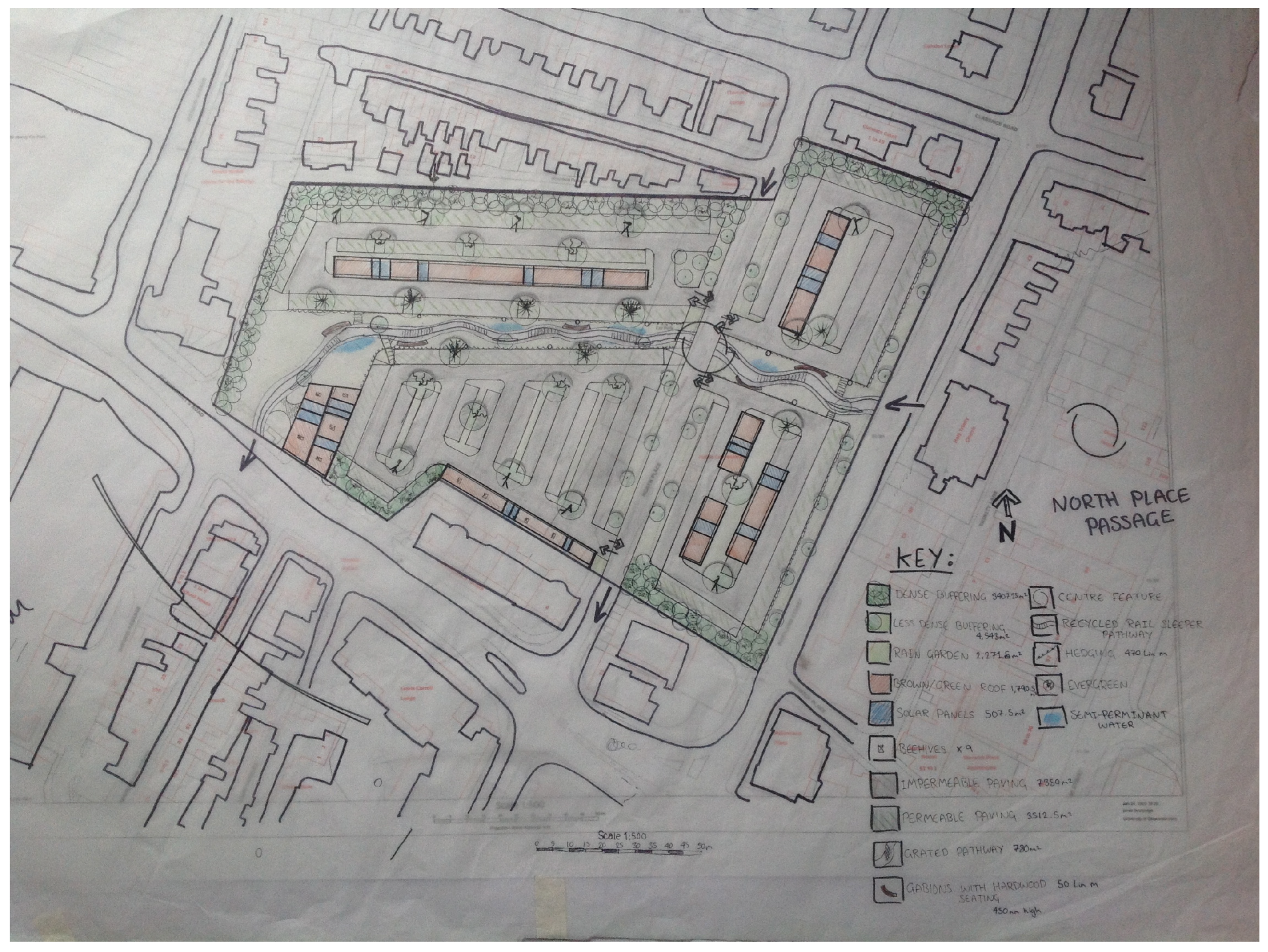

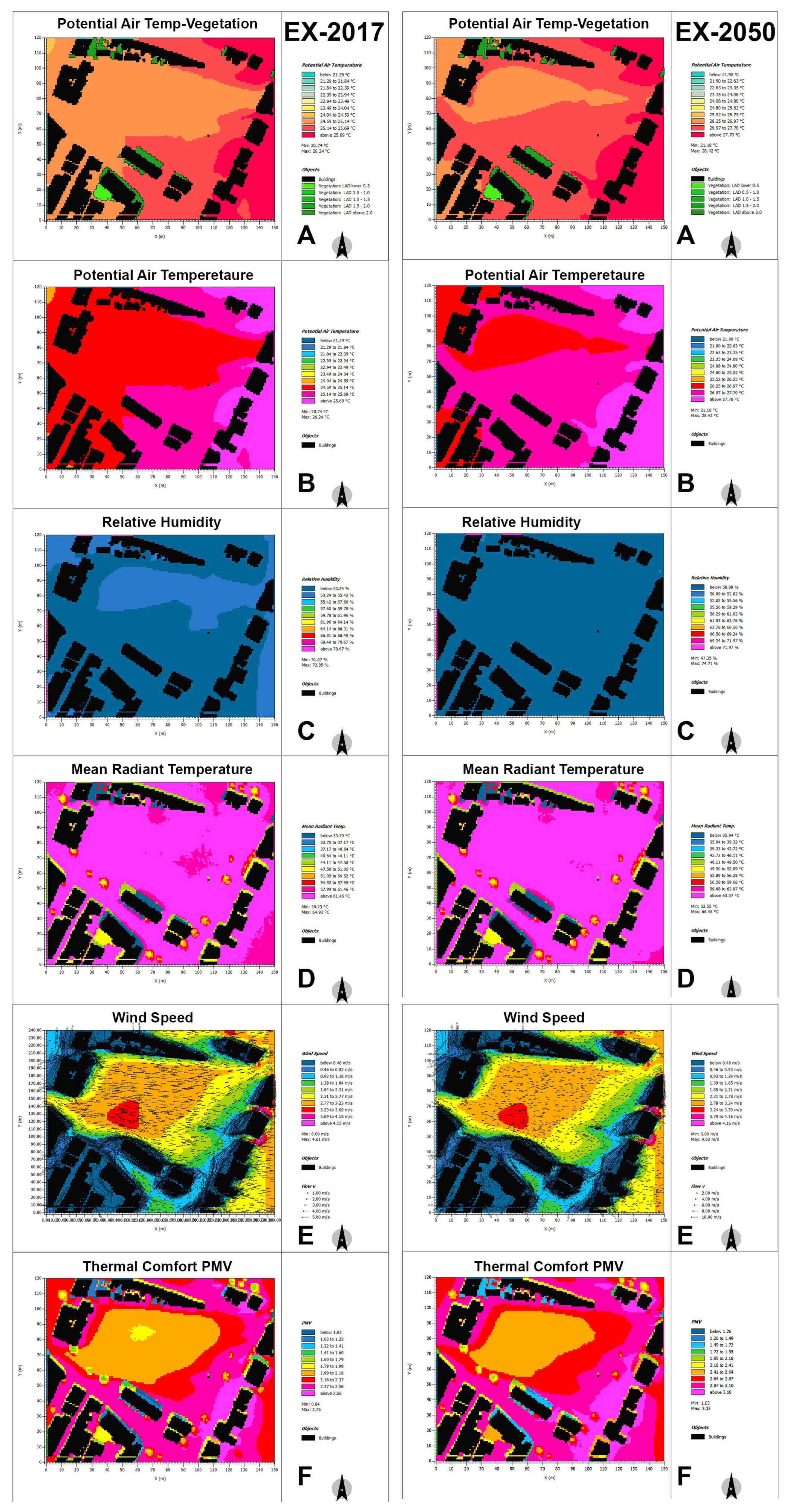



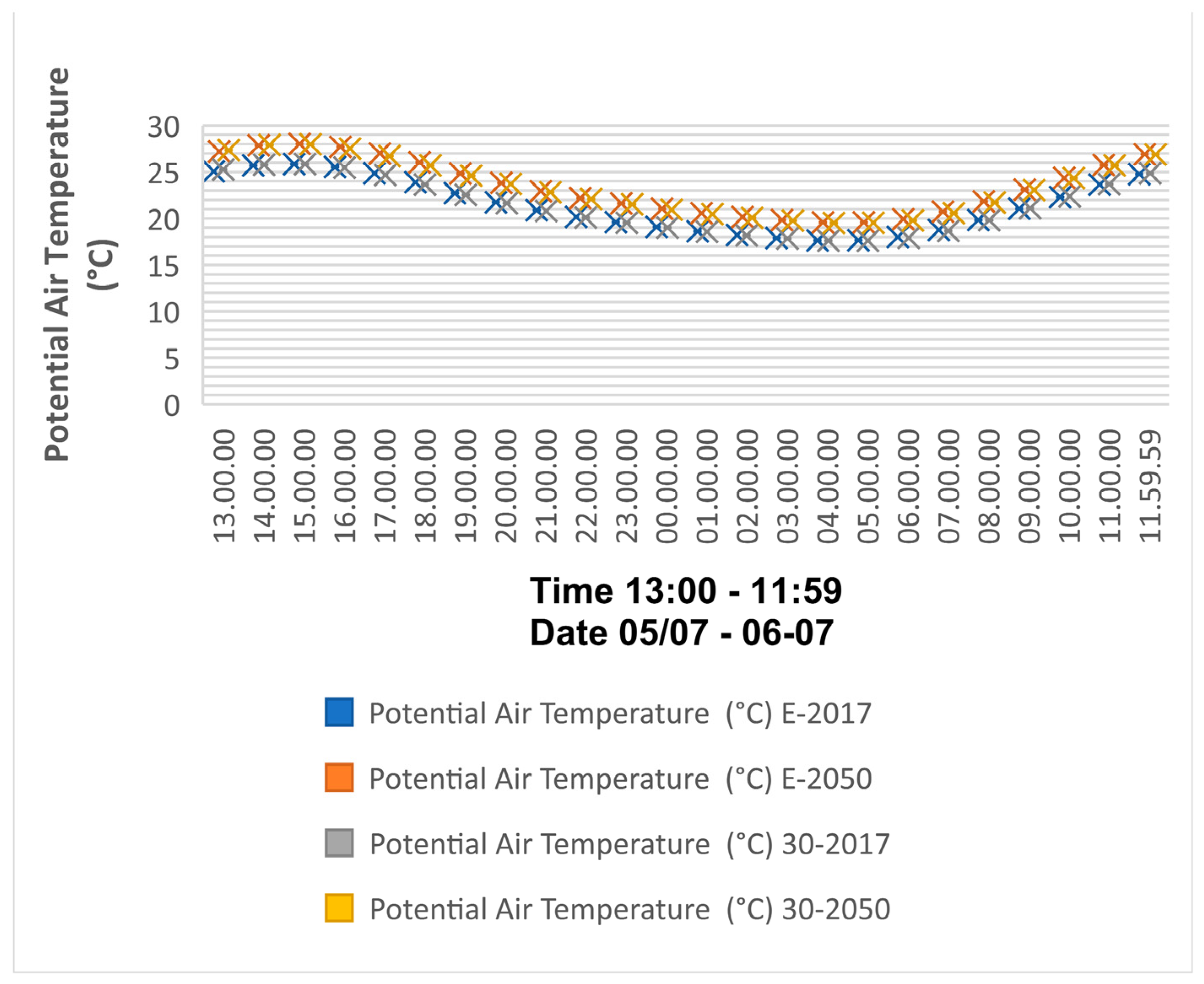
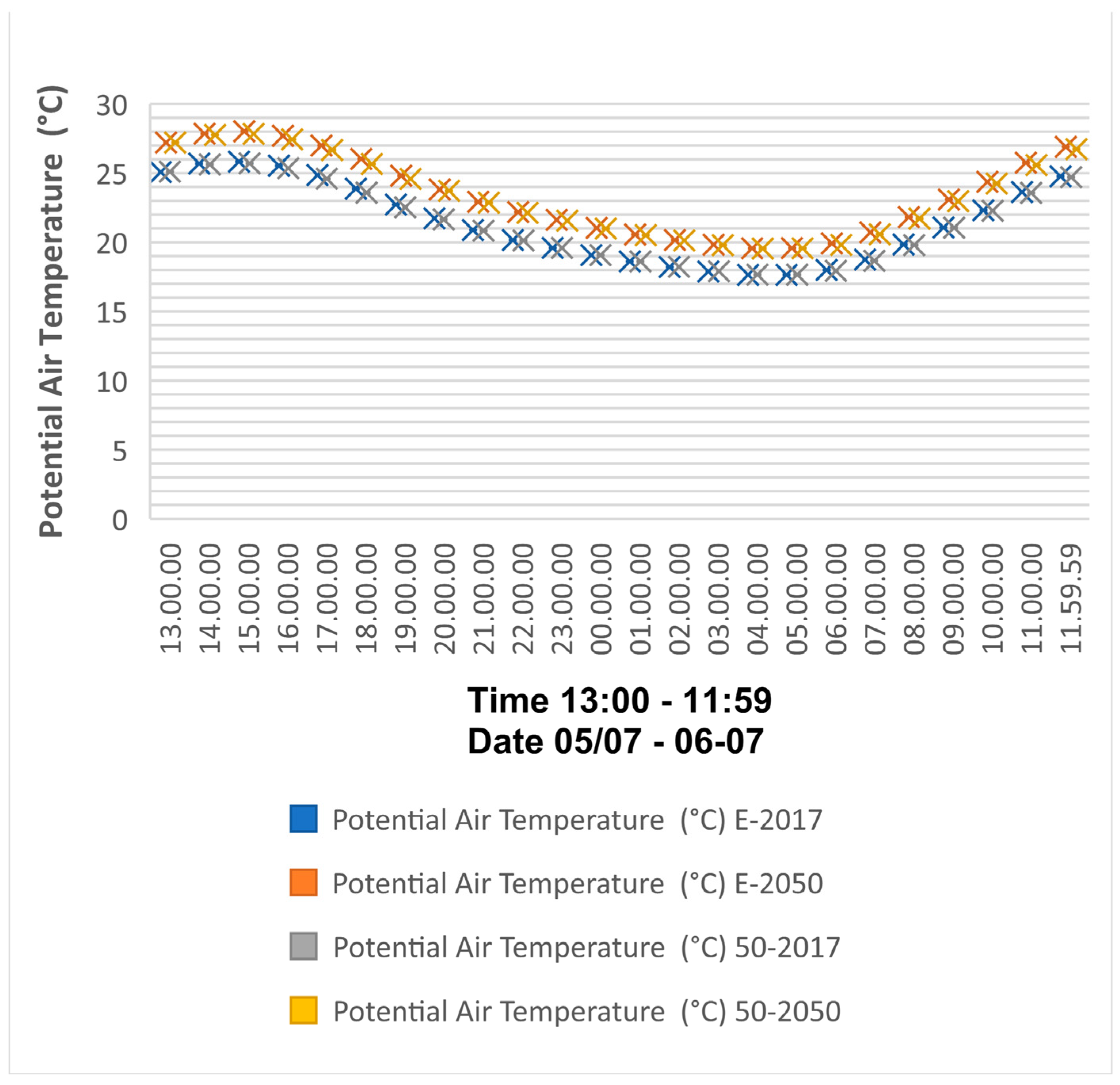
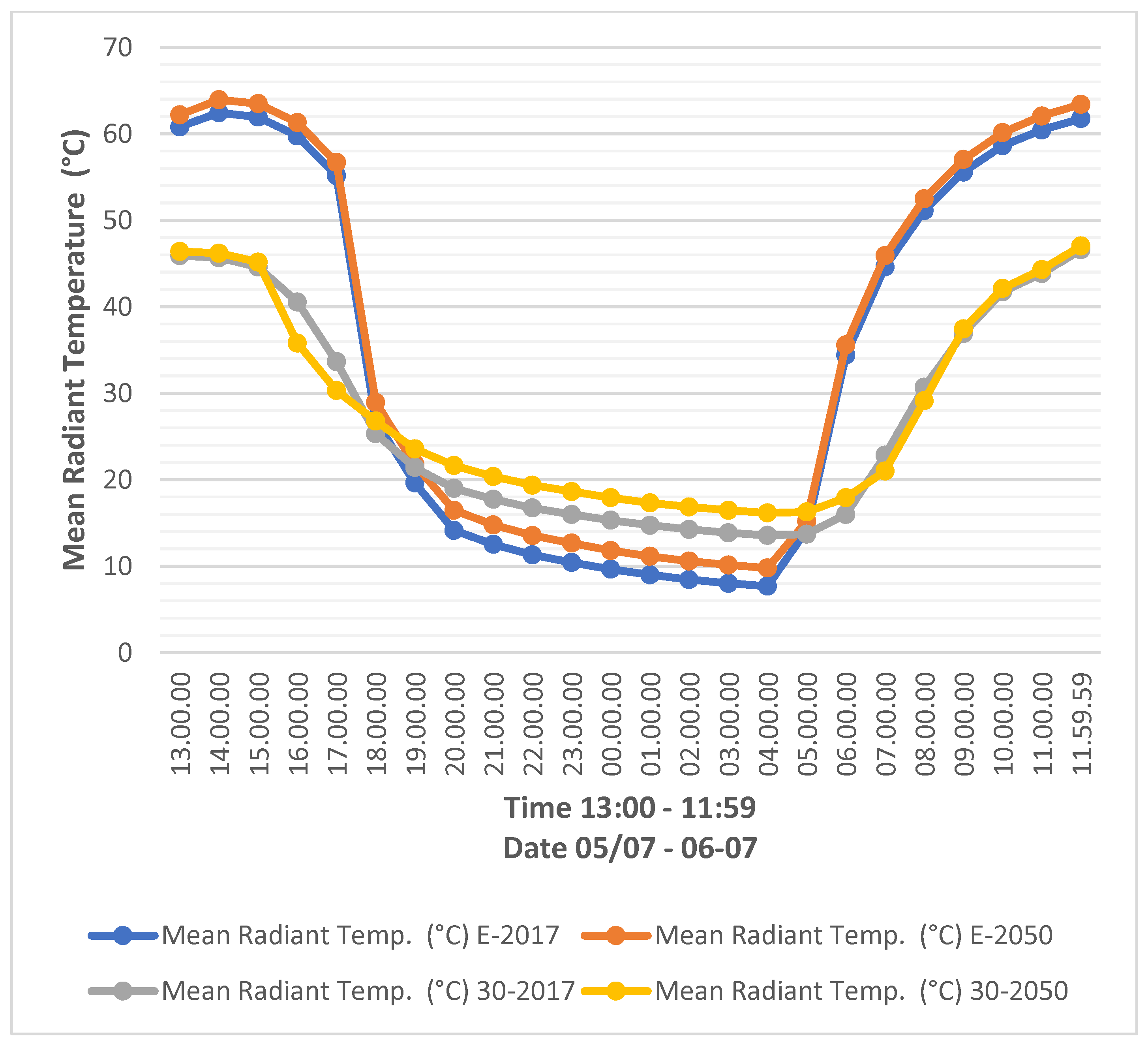
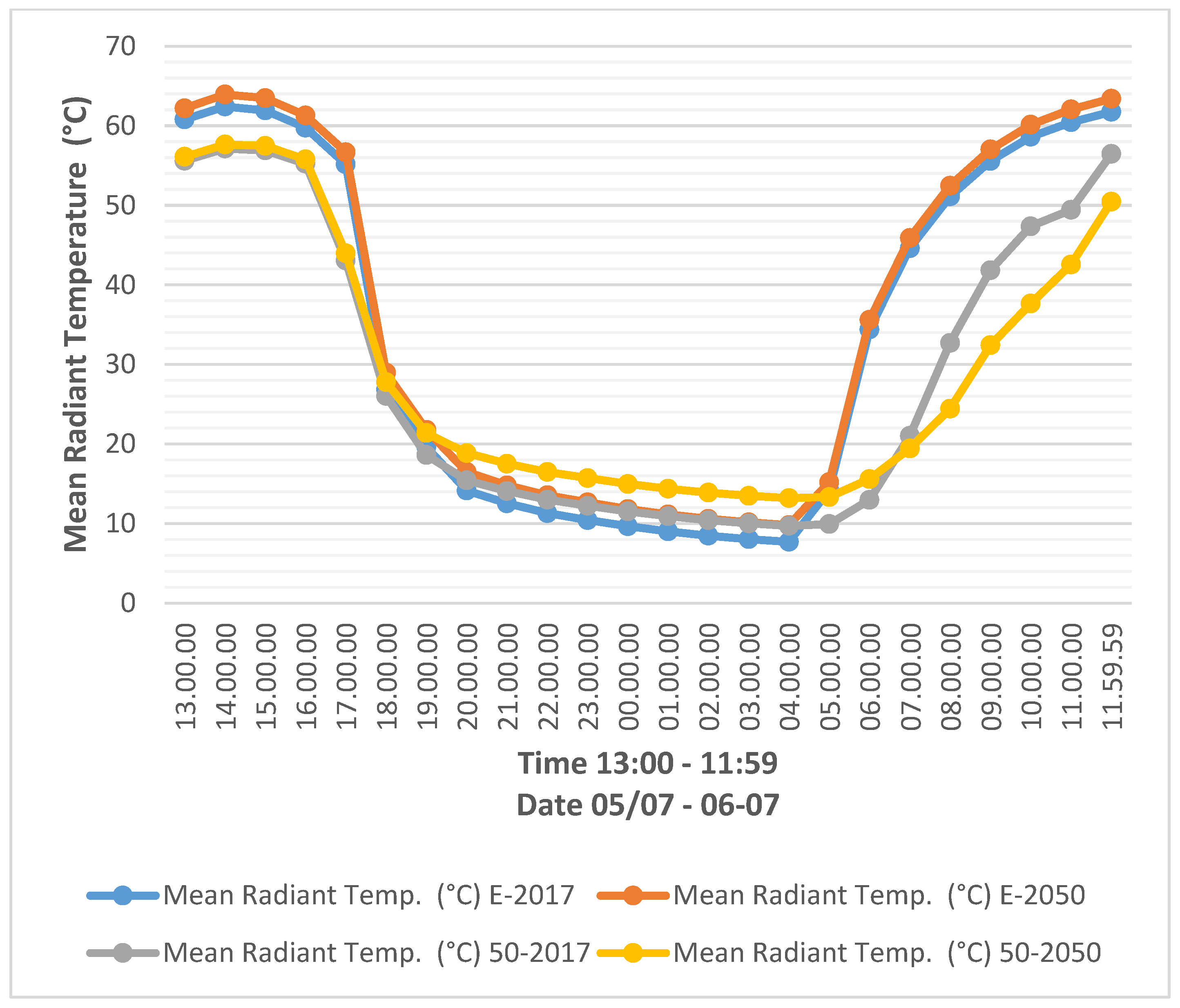

Disclaimer/Publisher’s Note: The statements, opinions and data contained in all publications are solely those of the individual author(s) and contributor(s) and not of MDPI and/or the editor(s). MDPI and/or the editor(s) disclaim responsibility for any injury to people or property resulting from any ideas, methods, instructions or products referred to in the content. |
© 2023 by the authors. Licensee MDPI, Basel, Switzerland. This article is an open access article distributed under the terms and conditions of the Creative Commons Attribution (CC BY) license (https://creativecommons.org/licenses/by/4.0/).
Share and Cite
Torkfar, P.; Russo, A. Assessing the Benefits of Climate-Sensitive Design with Nature-Based Solutions for Climate Change Adaptation in Urban Regeneration: A Case Study in Cheltenham, UK. Sustainability 2023, 15, 15855. https://doi.org/10.3390/su152215855
Torkfar P, Russo A. Assessing the Benefits of Climate-Sensitive Design with Nature-Based Solutions for Climate Change Adaptation in Urban Regeneration: A Case Study in Cheltenham, UK. Sustainability. 2023; 15(22):15855. https://doi.org/10.3390/su152215855
Chicago/Turabian StyleTorkfar, Pourya, and Alessio Russo. 2023. "Assessing the Benefits of Climate-Sensitive Design with Nature-Based Solutions for Climate Change Adaptation in Urban Regeneration: A Case Study in Cheltenham, UK" Sustainability 15, no. 22: 15855. https://doi.org/10.3390/su152215855
APA StyleTorkfar, P., & Russo, A. (2023). Assessing the Benefits of Climate-Sensitive Design with Nature-Based Solutions for Climate Change Adaptation in Urban Regeneration: A Case Study in Cheltenham, UK. Sustainability, 15(22), 15855. https://doi.org/10.3390/su152215855







